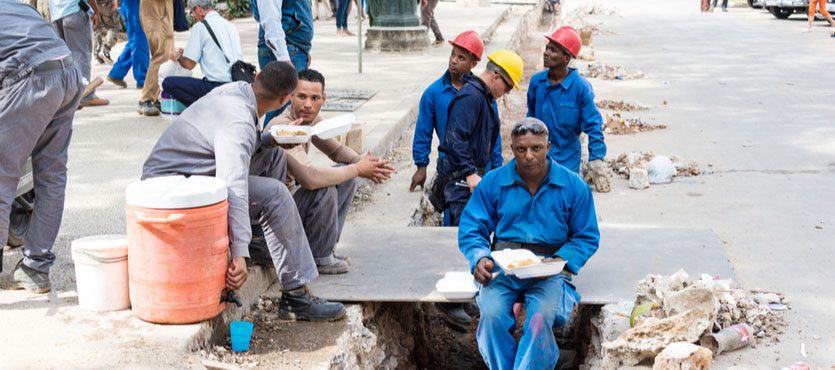Nestled amongst a sea of beach resorts and scuba clubs, the United States Navy’s Atlantic Undersea Test and Evaluation Center in the Bahamas is about as far from Iraq or Afghanistan as one can get, but injured contractors in both locations are entitled to the same benefits.
In the late 1940s and 1950s, as early Cold War tensions mounted, the Navy’s growing need for a deep-water testing facility eventually brought officials to Andros Island. Close to shore, the water is only about 30 feet deep, but it plunges to depths of over 13,000 feet just a little further out, making the location ideal for this kind of work. AUTEC officially opened in 1959. Almost immediately, researchers accomplished significant milestones in areas like sonar and acoustic measurement which were then considered vital to the national defense. Today, this mission continues, as AUTEC focuses on three-dimensional hydrospace and aerospace trajectory measurements running the entire spectrum of undersea simulated warfare: classification, detection, and then destruction. Boulder-based KIRA is one of the largest private contractors on the island, providing range and facilities management as well as fire suppression, pest control, ground maintenance, sewer, and other services.
With a land area roughly the size of Delaware, Andros Island is larger than the other 700 islands in the Bahamas combined.
Non-Military Contractors
Until 1978, all private military contractors who worked for the U.S. government filled support roles, like the KIRA contractors in paradise, um, AUTEC. Then, the U.S. General Accounting Office announced that it would no longer construe the 19th century Anti-Pinkerton Act as banning all employment of any armed paramilitary contractor.
What was seen as a sea change at the time, and is still controversial in many respects, may not be as important as some people think because about 80% of the jobs in the military are non-combat roles. These include jobs like the ones mentioned above, as well as things like:
- Cooks,
- Mechanics,
- Administrative support,
- Planners, and
- Meteorologists.
Additionally, a great number of contractors work on reconstruction projects. In many cases, these projects employ local laborers who do the actual building, and managers from United States-based contracting firms to direct the work.
Opportunities for reconstruction work abound. In many cases, war refugees will not return until the civilian infrastructure has been completely rebuilt, and that means roads, bridges, schools, hospitals, grocery stores, and places of business. These costs are massive, and Syria is a good example. The latest estimates are that the government will need $1 trillion to rebuild once hostilities end.
Dangers Non-Military Contractors Face
Even though construction workers in the United States have several layers of protection, the work they do is still dangerous. For example, attorneys often file workers’ compensation and other claims to keep companies somewhat honest, and government watchdogs, such as the Occupational Safety and Health Administration, do likewise.
In many foreign countries, especially those recovering from wars, there is essentially no legal infrastructure. Furthermore, if there is a government watchdog, bureaucrats often have different priorities other than protecting workers.
Some common dangerous issues at construction sites include:
- Falls: Unintentional falls, largely due to either a lack of safety equipment or a lack of training on existing equipment, fall dangers are the most frequently-cited OSHA violation and also the leading cause of death at construction sites.
- Faulty Electrical Systems: At busy construction sites, it is often difficult to distinguish between a live wire and a dead one. Moreover, many workers must use worn or outdated electrical equipment that carries additional risks.
- Trucks and Vehicles: At many construction sites, inexperienced workers operate very large machines, and the workers bear the brunt of these dangers.
Due to these risks and the additional risk of armed sabotage, this kind of work is especially dangerous overseas.
Compensation Available
Even though these contractors do not carry guns, injury compensation is still available through the Defense Base Act. As far back as Biblical times, commanders recognized that front-line troops, soldiers that guard the supply lines, and support personnel, such as medics, all contribute equally to battlefield success.
U.S. lawmakers recognized this as well, which is why they set up an injury compensation plan for any contractors who work in “war zones,” a term of art which basically means any foreign country that has at least one U.S. military base. The DBA created a federal workers’ compensation program which provides injured contractors with compensation for their:
- Lost Wages: Typically, injured victims receive two-thirds of their average weekly wages for the duration of their temporary disabilities. If their disabilities are permanent, the DBA can provide for a lump sum amount or life-time payments.
- Medical Bills: The DBA insurance company normally pays providers directly. These benefits cover not only medical bills, but other associated costs as well, such as physical rehabilitation and medical devices.
Most injured contractors can choose their own doctors and change physicians at any time during the course of therapy or treatment.
For more information about Defense Base Act coverage, contact Barnett, Lerner, Karsen & Frankel PA.

